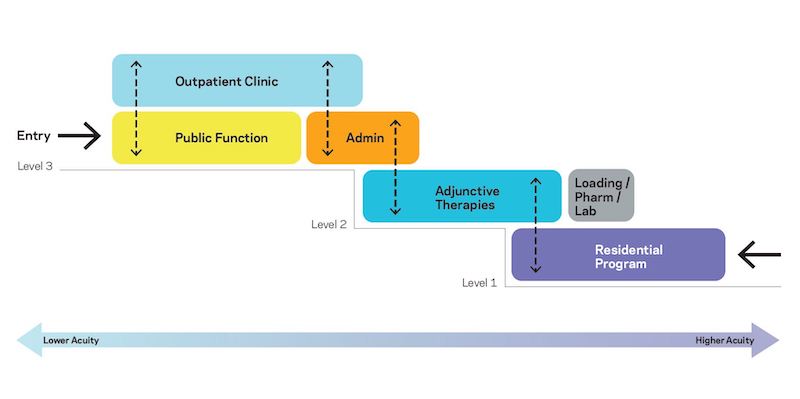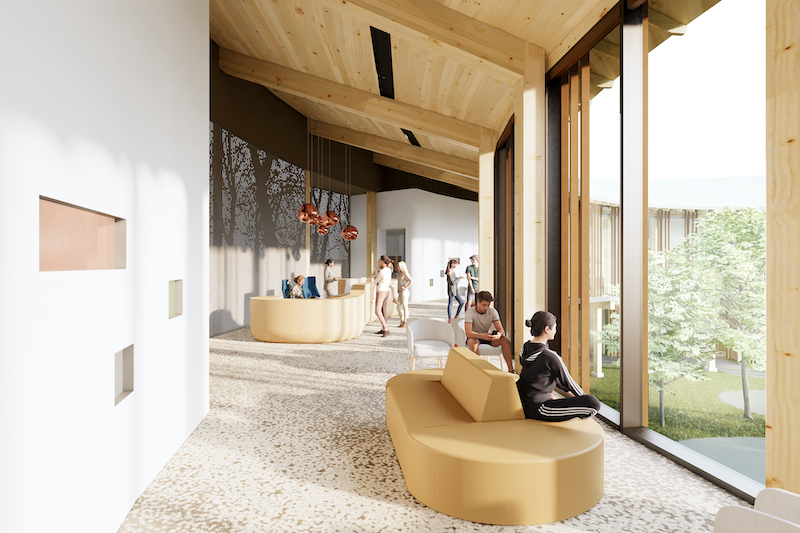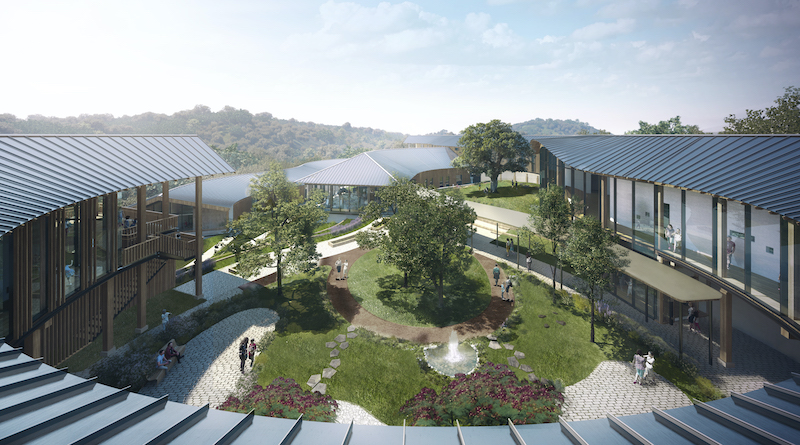A survey of 1,313 Americans ages 18 or older, which KFF Tracking conducted last July, found that more than half of those polled, 53%, reported their mental health had been negatively impacted by the coronavirus pandemic. Even before the virus started spreading, an estimated 26% of Americans suffered from diagnosable mental disorder in a given year, according to the National Institute of Mental Health Disorders.
The demand for healthcare facilities that offer mental and behavioral health services is increasing, and presents new design and construction opportunities to AEC firms.
About a year ago, on March 10, 2020, Nationwide Children’s Hospital debuted its nine-story $159 million Big Lots Behavioral Health Pavilion in Columbus, Ohio. The pavilion, designed by NBBJ and built by Turner Construction, opened as the largest pediatric facility for this specialty in the country. It has 48 inpatient beds, a psychiatric crisis department, 10 rooms for observation stays up to 24 hours, a 12-bed stabilization unit for stays up to 72 hours, and a range of outpatient treatment.

The proposed programming for the Ohana Center for Health is devised to offer a healing environment.
NBBJ also designed the 55,600-sf Ohana Center for Health in Monterey, Calif., which recently broke ground and is scheduled to open in early 2023. The project’s construction and programming are being funded by a $105.8 million donation to the Montage Health Foundation from Roberta Bialek Elliott, the sister of billionaire investor Warren Buffett. Ms. Elliott lives in Monterey and previously served on Montage Health’s Board of Trustees, according to the Chronicle of Philanthropy.
The Building Team on the Ohana Center for Health includes South Bay Construction (GC), Integral Group (MEP), Fast + Epp (SE), Whitson Engineers (CE), and BFS Landscape Architects (landscape).
BRINGING A HUMAN TOUCH TO HEALTHCARE
Jonathan Ward, FAIA, Design Partner in NBBJ’s Los Angeles office, tells BD+C that his firm’s longstanding commitment to humanizing healthcare makes it a good fit for this trend for behavioral and mental health facilities. “Before the pandemic, most of these places weren’t very nice. Now, society is destigmatizing mental health, and here is an opportunity for people to get treatment in better settings.”
“Ohana” means “family” in Hawaiian, and this venture will include everything from an actual “Ohana House” (a kind of apartment) to early intervention, comprehensive support for young people and their families, and partnerships with an extensive collection of existing community organizations.
“We envision a warm, welcoming center on Montage Health property at Ryan Ranch,” said Dr. Steven Packer, President and CEO of Montage Health. “But we see much more than bricks and mortar—a groundbreaking hub for comprehensive, innovative solutions, with concentric circles of care emanating throughout our community.”
According to Montage Health, there is a critical shortage of psychiatrists at a time when as many as one in five children ages 9 to 17 in the U.S. may have a diagnosable psychiatric disorder.
CLT USED EXTENSIVELY

The residential hub (above) and outpatient lobby (below) accentuate how cross-laminated timber is being used throughout the facility.
 NBBJ’s design for Ohana Center for Health brings together the latest in neuroscience research—Ward says his firm consulted with the brain scientist and author Dr. John Medina—to provide a healing environment for children and teenagers, as well as for caregivers who, in this field, have an annual turnover rate that exceeds 40%.
NBBJ’s design for Ohana Center for Health brings together the latest in neuroscience research—Ward says his firm consulted with the brain scientist and author Dr. John Medina—to provide a healing environment for children and teenagers, as well as for caregivers who, in this field, have an annual turnover rate that exceeds 40%.
The design immerses the Center in what Ward calls “an intentional connection to nature,” by creating a series of large outdoor cloisters, patios, and terraced spaces. Flowing water wends through the site. Prospect and refuge spaces offer privacy and natural views. Gardens with immune-boosting plants such as lavender and rosemary offer therapy and music to patients and visitors.
The Center is designed to encourage movement, which boosts the executive function of the brain in ways said to reduce mental illness. The Center will include a gym, outdoor nature trails and other forms of outside activities.
Another humanizing aspect of the design, says Ward, is its use of cross-laminated timber (CLT). This is one of the largest healthcare projects in the country to use CLT, whose modular components can be assembled offsite. The use of this composite material helps lower the facility’s carbon footprint, and will reduce materials waste during construction.
Related Stories
| Sep 10, 2013
BUILDINGChicago eShow Daily – Day 2 coverage
The BD+C editorial team brings you this real-time coverage of day 2 of the BUILDINGChicago/Greening the Heartland conference and expo taking place this week at the Holiday Inn Chicago Mart Plaza.
| Sep 4, 2013
Augmented reality goes mainstream: 12 applications for design and construction firms
Thanks to inexpensive mobile devices and increasingly advanced software apps, Building Teams are finally able to bring their BIM models to life on the job site.
| Sep 4, 2013
Smart building technology: Talking results at the BUILDINGChicago/ Greening the Heartland show
Recent advancements in technology are allowing owners to connect with facilities as never before, leveraging existing automation systems to achieve cost-effective energy improvements. This BUILDINGChicago presentation will feature Procter & Gamble’s smart building management program.
| Aug 30, 2013
A new approach to post-occupancy evaluations
As a growing number of healthcare institutions become more customer-focused, post-occupancy evaluations (POE) are playing a bigger role in new construction and renovation projects. Advocate Health Care is among the healthcare organizations to institute a detailed post-occupancy assessment process for its projects.
| Aug 26, 2013
What you missed last week: Architecture billings up again; record year for hotel renovations; nation's most expensive real estate markets
BD+C's roundup of the top construction market news for the week of August 18 includes the latest architecture billings index from AIA and a BOMA study on the nation's most and least expensive commercial real estate markets.
| Aug 26, 2013
13 must-attend continuing education sessions at BUILDINGChicago
Building Design+Construction's new conference and expo, BUILDINGChicago, kicks off in two weeks. The three-day event will feature more than 65 AIA CES and GBCI accredited sessions, on everything from building information modeling and post-occupancy evaluations to net-zero projects and LEED training. Here are 13 sessions I'm planning to attend.
| Aug 22, 2013
Energy-efficient glazing technology [AIA Course]
This course discuses the latest technological advances in glazing, which make possible ever more efficient enclosures with ever greater glazed area.
| Aug 14, 2013
Green Building Report [2013 Giants 300 Report]
Building Design+Construction's rankings of the nation's largest green design and construction firms.
| Jul 30, 2013
Better planning and delivery sought for VA healthcare facilities
Making Veterans Administration healthcare projects “better planned, better delivered” is the new goal of the VA’s Office of Construction and Facilities Management.
| Jul 30, 2013
Healthcare designers get an earful about controlling medical costs
At the current pace, in 2020 the U.S. will spend $4.2 trillion a year on healthcare; unchecked, waste would hit $1.2 trillion. Yet “waste” is keeping a lot of poorly performing hospitals in business, said healthcare facility experts at the recent American College of Healthcare Architects/AIA Academy of Architecture for Health Summer Leadership Summit in Chicago.

















